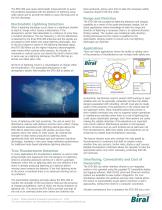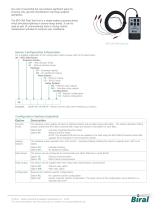
Excertos do catálogo

Bfral Visibly Better BTD-300 Thunderstorm (Lightning) Detector Datasheet Standalone lightning detector giving range and direction data to FAA requirements Unique quasi-electrostatic operating principle virtually eliminates false alarms Warns of overhead thunderstorm risk before the first lightning discharge KEY FEATURES & BENEFITS 9 Warns of overhead lightning risk even before the first lightning discharge 9 Highly immune to radio interference which is the major cause of false alarms in traditional standalone detectors 9 83 km (45 NM) detection range exceeds the US Federal Aviation Administration requirements 9 Detects cloud-to-ground and as well as weaker but more common cloud-to-cloud lightning 9 Detects charged precipitation 9 Meets FAA performance requirements for aerodrome use 9 Meets EN50536:2011+A1:2012 requirements for a Class 1 detector 9 Meets IEC 62793 performance requirements for a Class A detector 9 Optional direction finder The BTD-300 Thunderstorm Detector is a standalone sensor that reliably detects the presence of all forms of lightning to a range of 83 km. The unique quasi electrostatic operating principle gives the detector a very low false alarm rate and the ability to warn of the risk of overhead lightning. Virtually maintenance free, the BTD-300 can operate with the supplied PC compatible display software, seamlessly integrate with sophisticated weather monitoring systems or directly activate local warning devices. Lightning Detection Virtually all commercially available lightning detection sensors and systems use the reception of radio waves generated by lightning discharges as the primary detection technique. Whilst providing a sensitive method of detection the many other sources of radio waves such as arcs from electrical equipment, vehicle ignition systems and fixed or mobile transmitters can result in very high false alarm rates. Lightning detection networks resolve this problem through the use of multiple sensors spaced tens or hundreds of kilometres apart combined with signal processing and triangulation. Such networks are typically very costly to install and operate and are therefore only usually operated by national weather services. Standalone radio based lightning detectors often employ secondary measurements such as optical flash detection in an attempt to reduce false alarms and employ complex signal analysis to estimate range. These techniques are only partially effective, giving these older technology standalone lightning detectors a poor reputation due to their high false alarm rate and poor distance accuracy.
Abrir o catálogo na página 1
The BTD-300 uses quasi electrostatic measurements to avoid the problems associated with the detection of lightning using radio waves and to provide the ability to issue warnings prior to the first discharge. Electrostatic Lightning Detection When a lightning discharge occurs there is a significant transfer of electric charge which causes a disturbance in the atmospheric electric field detectable to a distance of more than a hundred kilometres. The low frequency (<50 Hz) disturbance is detected by the three BTD-300 antennas and the signals are processed to both detect and range lightning...
Abrir o catálogo na página 2
Sensor Configuration Information low cost of ownership but can produce significant gains by ensuring only genuine thunderstorm warnings suspend operations. The BTD-300 Field Test Unit is a simple battery powered device which simulates lightning in several range bands. It can be used as part of commissioning tests or during routine maintenance activities to enhance user confidence. For a detailed explanation of the configuration options please refer to the table below. 30 - BTD-300 Sensor Direction Finder: WF - With direction finder NF - Without direction finder Heating: EH - Extended...
Abrir o catálogo na página 3
Self-test capability Included with Sensor The sensor is delivered in sturdy recyclable foam filled packaging with: - Display and logging software - User manual and calibration certificates Accessories - Optional Update rate Specifications are subject to review and change without notice. E&OE. Sensor supply Operating temperature - with extended heating Power Requirements Certification & Compliance CE Certified EMC compliance with EN61326-1997, 1998, 2001 Compliance with EN50536:2011+A1:2012 for a Class 1 detector Performs in accordance with IEC 62793 for a Class A detector RoHS and WEEE...
Abrir o catálogo na página 4Todos os catálogos e folhetos técnicos BIRAL - BRISTOL INDUSTRIAL & RESEARCH ASSOCIATES
-
VPF-710 Visibility Sensor
4 Páginas
-
ALS-2 Ambient Light Sensor
4 Páginas
-
CBME80B Cloud Ceilometer
2 Páginas
-
BTD-200
2 Páginas
-
VPF-TEST
1 Páginas
-
SWS-050 Visibility Sensor
4 Páginas
-
SWS-100LW Visibility Sensor
4 Páginas












